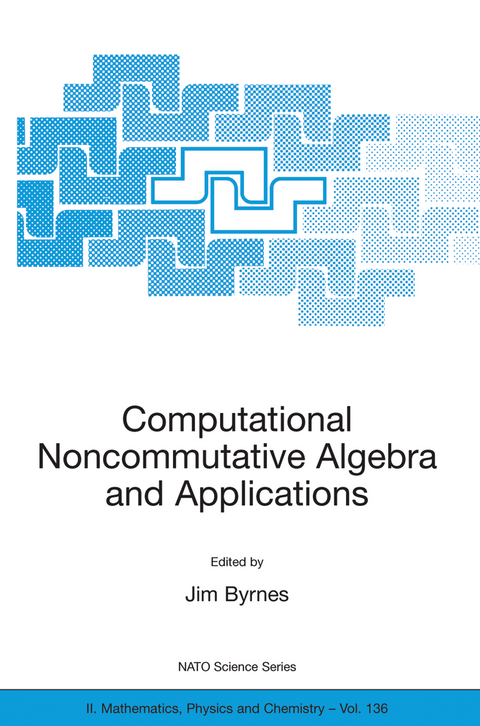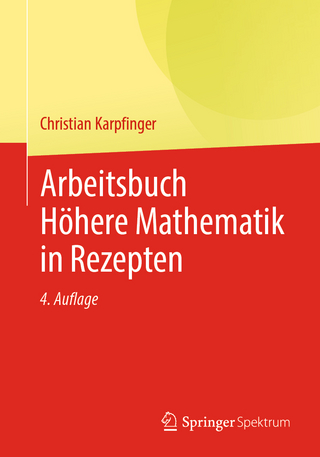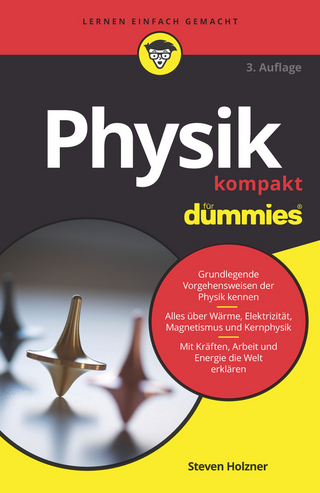
Computational Noncommutative Algebra and Applications
Springer-Verlag New York Inc.
978-1-4020-1983-8 (ISBN)
Preface JIM BYRNES The chapters in this volume were presented at the July 2003NATO Advanced Study Institute on Computational Noncommutative Algebra and Applications. The conference was held at the beautiful Il Ciocco - sort near Lucca, in the glorious Tuscany region of northern Italy. Once again we gathered at this idyllic spot to explore and extend the re- procity between mathematics and engineering. The dynamic interaction between world-renowned scientists from the usually disparate com- nities of pure mathematicians and applied scientists, which occurred at our 1989, 1991, 1992, 1998, and 2000 ASI's, continued at this meeting. The fusion of algebra, analysis and geometry, and their application to real world problems, have been dominant themes underlying mat- matics for over a century. Geometric algebras, introduced and classi?ed by Cli?ord in the late 19th century, have played a prominent role in this e?ort, as seen in the mathematical work of Cartan, Brauer, Weyl, Chevelley, Atiyah, and Bott, and in applications to physics in the work of Pauli, Dirac and others.
One of the most important applications of geometric algebras to geometry is to the representation of groups of - clidean and Minkowski rotations. This aspect and its direct relation to robotics and vision were discussed by several of the Principal Lecturers, and are covered in this book.
Dedication. Preface. Acknowledgments. Clifford Geometric Algebras in Multilinear Algebra and Non-Euclidean Geometries.- Geometric algebra Projective Geometries;Affine and other geometries; Affine Geometry of pseudo-euclidean space; Conformal Geometry and the Horosphere; References. Content-Based Information Retrieval by Group Theoretical Methods.- Introduction; Motivating Examples; General Concept; Fault Tolerance.- Applications, Prototypes, and Test Results; Related Work and Future Research; References.- Four Problems in Radar.-Introduction; Radar Fundamentals; Radar Waveforms; Signal Processing; Space-Time Adaptive Processing; Four Problems in Radar; Conclusions. Introduction to Generalized Classical and Quantum Signal and System Theories on Groups and Hypergroups.-Generalized classical signal/system theory on hypergroups; Generalized quantum signal/system theory on hypergroups; Conclusion; References. Lie Groups and Lie Algebras in Robotics.- Introduction—Rigid Body Motions; Lie Groups; Finite Screw Motions; Mechanical Joints; Invisible Motion and Gripping; Forward Kinematics; Lie Algebra; The Adjoint Representation; The Exponential Map Derivatives of Exponentials; Jacobians; Concluding Remarks; References. Quantum/Classical Interface: a Geometric Approach from the Classical Side.- Introduction Paravector Space as Spacetime; Eigenspinors; Spin; Dirac Equation; Bell’s Theorem; Qubits and Entanglement; Conclusions; References. PONS, Reed-Muller Codes, and Group Algebras.- Introduction; Analytic Theory of One-Dimensional PONS (Welti);Shapiro Sequences, Reed-Muller Codes, and Functional Equations;Group Algebras; Reformulation of Classical PONS; Group Algebra of Classical PONS; Group Algebra Convolution; Splitting Sequences; Historical Appendix on PONS; References. Clifford Algebras as a Unified Language.- Introduction; Clifford algebras as models of physical spaces; Clifford Algebras as Models of Perceptual MulticolorSpaces; Hypercomplex-Valued invariants of nD multicolor images; Conclusions; Acknowledgments; References. Recent Progress and Applications in Group FFTs.- Introduction; Finite group FFTs; FFTs for compact groups; Noncompact groups; References. Group Filters and Image Processing.- Introduction: Classical Digital Signal Processing; Abelian Group DSP; Nonabelian Groups; Examples; Group Transforms; Group Filters; Line-like Images; Acknowledgments; References. A Geometric Algebra Approach to Some Problems of Robot Vision.- Introduction; Local Analysis of Multi-dimensional Signals; Knowledge Based Neural Computing; Acknowledgments; References. Group Theory in Radar and Signal Processing.- Introduction; How a Radar Works;Representations; Representations and Radar; Ambiguity Functions;The Wide Band Case; References. Geometry of Paravector Space with Applications to Relativistic Physics.- Clifford Algebras in Physics; Paravector Space as Spacetime; Interpretation; Eigenspinors; Maxwell’s Equation; Conclusions; References. A Unified Approach to Fourier-Clifford-Prometheus Transforms- Introduction; New construction of classical and multiparametric Prometheus transforms; PONS associated with Abelian groups; Fast Fourier-Prometheus Transforms; Conclusions; Acknowledgments; References. Fast Color Wavelet Transforms.- Introduction; Color images; Color Wavelet-Haar-Prometheus transforms;Edge detection and compression of color images; Conclusion; Acknowledgments; References. Selected Problems; Various Authors.- Transformations of Euclidean Space and Clifford Geometric; Algebra ;References; On the Distribution of Kloosterman Sums on Polynomials over Quaternions; References; Harmonic Sliding Analysis Problems; References; Spectral Analysis under Conditions of Uncertainty; A Canonical Basis for Maximal Tori of the Reductive Centrizer of a Nilpotent Element; References;6 The Quantum Chaos Conjecture References; Four Problems in Radar; Topic Index; Author Index
Dedication. Preface. Acknowledgments. Clifford Geometric Algebras in Multilinear Algebra and Non-Euclidean Geometries.- Geometric algebra
Projective Geometries;Affine and other geometries; Affine Geometry of pseudo-euclidean space; Conformal Geometry and the Horosphere; References.
Content-Based Information Retrieval by Group Theoretical Methods.- Introduction; Motivating Examples; General Concept; Fault Tolerance.- Applications, Prototypes, and Test Results; Related Work and Future Research; References.- Four Problems in Radar.-Introduction; Radar Fundamentals; Radar Waveforms; Signal Processing; Space-Time Adaptive Processing; Four Problems in Radar; Conclusions. Introduction to Generalized Classical and Quantum Signal and System Theories on Groups and Hypergroups.-Generalized classical signal/system theory on hypergroups; Generalized quantum signal/system theory on hypergroups; Conclusion; References. Lie Groups and Lie Algebras in Robotics.- Introduction—Rigid Body Motions; Lie Groups; Finite Screw Motions; Mechanical Joints; Invisible Motion and Gripping; Forward Kinematics; Lie Algebra; The Adjoint Representation; The Exponential Map Derivatives of Exponentials; Jacobians; Concluding Remarks; References. Quantum/Classical Interface: a Geometric Approach from the Classical Side.- Introduction
Paravector Space as Spacetime; Eigenspinors; Spin; Dirac Equation; Bell’s Theorem; Qubits and Entanglement; Conclusions; References. PONS, Reed-Muller Codes, and Group Algebras.- Introduction; Analytic Theory of One-Dimensional PONS (Welti);Shapiro Sequences, Reed-Muller Codes, and Functional Equations;Group Algebras;
Reformulation of Classical PONS; Group Algebra of Classical PONS; Group Algebra Convolution; Splitting Sequences; Historical Appendix on PONS; References.
Clifford Algebras as a Unified Language.- Introduction; Clifford algebras as models of physical spaces; Clifford Algebras as Models of Perceptual MulticolorSpaces;
Hypercomplex-Valued invariants of nD multicolor images; Conclusions; Acknowledgments; References. Recent Progress and Applications in Group FFTs.-
Introduction; Finite group FFTs; FFTs for compact groups; Noncompact groups; References. Group Filters and Image Processing.- Introduction: Classical Digital Signal Processing; Abelian Group DSP; Nonabelian Groups; Examples; Group Transforms; Group Filters; Line-like Images; Acknowledgments; References. A Geometric Algebra Approach to Some Problems of Robot Vision.- Introduction; Local Analysis of Multi-dimensional Signals; Knowledge Based Neural Computing; Acknowledgments; References. Group Theory in Radar and Signal Processing.- Introduction; How a Radar Works;Representations; Representations and Radar; Ambiguity Functions;The Wide Band Case; References. Geometry of Paravector Space with Applications to Relativistic Physics.- Clifford Algebras in Physics; Paravector Space as Spacetime; Interpretation; Eigenspinors; Maxwell’s Equation; Conclusions; References. A Unified Approach to Fourier-Clifford-Prometheus Transforms- Introduction; New construction of classical and multiparametric Prometheus transforms; PONS associated with Abelian groups; Fast Fourier-Prometheus Transforms; Conclusions; Acknowledgments; References. Fast Color Wavelet Transforms.- Introduction; Color images; Color Wavelet-Haar-Prometheus transforms;Edge detection and compression of color images; Conclusion; Acknowledgments; References. Selected Problems; Various Authors.- Transformations of Euclidean Space and Clifford Geometric; Algebra ;References; On the Distribution of Kloosterman Sums on Polynomials over Quaternions; References; Harmonic Sliding Analysis Problems; References;
Spectral Analysis under Conditions of Uncertainty; A Canonical Basis for Maximal Tori of the Reductive Centrizer of a Nilpotent Element; References;6 The Quantum Chaos Conjecture
References; Four Problems in Radar; Topic Index; Author Index
| Erscheint lt. Verlag | 3.9.2004 |
|---|---|
| Reihe/Serie | NATO Science Series II: Mathematics, Physics and Chemistry ; 136 |
| Zusatzinfo | XIV, 428 p. |
| Verlagsort | New York, NY |
| Sprache | englisch |
| Maße | 156 x 234 mm |
| Themenwelt | Mathematik / Informatik ► Mathematik ► Algebra |
| Mathematik / Informatik ► Mathematik ► Geometrie / Topologie | |
| Naturwissenschaften | |
| ISBN-10 | 1-4020-1983-1 / 1402019831 |
| ISBN-13 | 978-1-4020-1983-8 / 9781402019838 |
| Zustand | Neuware |
| Informationen gemäß Produktsicherheitsverordnung (GPSR) | |
| Haben Sie eine Frage zum Produkt? |
aus dem Bereich


